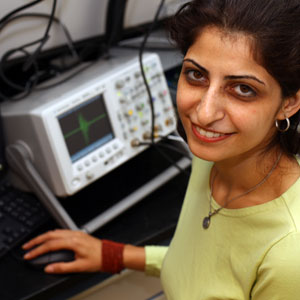 |
| Zhara Torbatian is doing a PhD in the BioMedic program. (Bruce Bottomley Photo) |
Consider a replacement hip joint or a tool that helps doctors perform delicate surgeries.
Whatever the medical technology, chances are it was developed by a specialist somewhere in the world. Now consider that Nova Scotia is becoming a major player in biomedical engineering and medical technology development and ¬È∂π¥´√Ω is right at the centre of things.
Just over a year ago ¬È∂π¥´√Ω received its first grant from the National Sciences and Engineering Research Council of Canada (NSERC) through the Collaborative Research and Training Experience (CREATE) program. The $1.6 million in funding was awarded to the School of Biomedical Engineering with the purpose of fostering a new kind of program, namely NSERC CREATE: BioMedic. Additional funds contributed by BioNova, a Nova Scotia industry biotechnology and life sciences association, the National Research Council and ¬È∂π¥´√Ω bring the total to¬Ýmore than¬Ý$2 million.
“The School of Biomedical Engineering is the body in which the BioMedic program exists,” explains Geoff Maksym, program director. Students can achieve master’s degrees or PhDs from either of Dal’s Biomedical Engineering programs.
Real world applications
Several courses differentiate BioMedic from the regular curriculum. These courses focus on business and clinical aspects that are important to students who may wish to start their own medical technology company upon graduation.
“Before this course existed, I never would have anticipated the interest in the business aspects that they all seem to have,” says Dr. Maksym. “They know it’s part of the real world. They just eat it up. It’s very practical.”
A partnership was formed between ¬È∂π¥´√Ω‚Äôs School of Biomedical Engineering and the School of Business Administration to facilitate this customized approach. The interdisciplinary model continues with a group of clinical mentors located on Dal campus and in nearby hospitals.
“Students get an additional qualification at the end which is going to be called a Diploma in Entrepreneurship,” says Eleanor Seaman-Bolton, program administrator for BioMedic. “In a nutshell it gives them additional skills to either work in a startup or small enterprise or potentially start their own business, so their focus is more commercial than if they were doing the general (Biomedical Engineering) program.”
Commercialization
Developing a product and assembling a dedicated sales force and marketing team is no longer profitable on a small scale. By gathering a team of experts and focusing on a very specialized medical technology, the working prototype can be sold to a large distributor that has its own sales and marketing departments in place. The sale provides the small company with profit to move on and work on developing their next piece of technology.
“And that’s good news for Nova Scotia because I think that’s the kind of thing that Halifax can achieve or Nova Scotia can achieve,” says Dr. Maksym.
Halifax can use the “intellectual capital” it has in its universities and hospitals to ensure success in the field of medical device commercialization.
Someone who is exploring these options is Zahra Torbatian. She has just completed the first year of her PhD in Biomedical Engineering in the BioMedic program. Ms. Torbatian’s area of focus is high frequency ultrasonic endoscopy for imaging the auditory system.
The inner ear contains the smallest bones in the human body, all of which are out of range for current imaging technologies. “CT and MRI are too low resolution to be useful,” explains Ms. Torbatian. Those methods offer a resolution of around 1 mm and a technology is required that will give a resolution in the order of microns, or 0.0001 cm.
'Lots of opportunities'
With the tiny probe she is developing, Ms. Torbatian hopes to provide quality images of the inner ear that will aid in diagnosis and treatment of auditory ailments. In fact, the medical uses for high frequency ultrasonic endoscopy are limited only by the imaginations of physicians.
“High frequency ultrasound is kind of untouched – needs skilled staff,” says Ms. Torbatian. “I know if I’m trained in this area I’m going to have lots of opportunities.”
Thus far in the program, Director Geoff Maksym is positive about the number of people who want to study in the BioMedic program in the School of Biomedical Engineering.
“It’s only a year in and so far the applicants exceed the positions, which is great,” he says. “That means other people think the idea is good and they want training. Put in good quality students and you’ll get a good quality program and likely some success stories.”
LINK:
